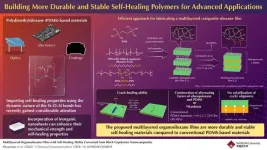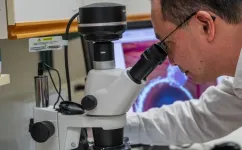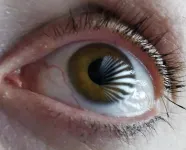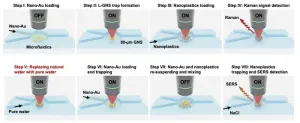(Press-News.org) DALLAS, April 1, 2025 — A New York City-based physician scientist who explores ways to improve health by looking at the ways in which cells and molecules impact disease and an epidemiologist from Baltimore who has devoted her career to identifying ways to improve screening, diagnosis and patient care for people with diabetes are the most recent American Heart Association Merit Award recipients. Over the next five years, each researcher will receive a total of $1 million in funding from the Association, a global force changing the future of health for all.
The American Heart Association’s Merit Award is one of the most prestigious competitive research awards given by the Association, the largest non-government funder of cardiovascular research in the United States. The Merit Award supports scientists who have consistently performed highly promising, novel research with the potential to move cardiovascular science forward quickly, with high impact. The recipients of the 2025 award are:
Ann Marie Schmidt, M.D., the Dr. Iven Young Professor of Endocrinology in the Department of Medicine, the Holman Division of Endocrinology, Diabetes and Metabolism and a professor in the Department of Biochemistry and Molecular Pharmacology and the Department of Pathology at NYU Grossman School of Medicine in New York City; and
Elizabeth (Liz) Selvin, Ph.D., M.P.H., FAHA, Director of the Welch Center for Prevention, Epidemiology and Clinical Research and a professor of epidemiology at the Johns Hopkins Bloomberg School of Public Health in Baltimore. She holds a joint appointment in the Division of General Internal Medicine, Department of Medicine at the Johns Hopkins University School of Medicine.
“Each year, the American Heart Association recognizes recipients of the Merit Awards as investigators with established track records of success in major research challenges in the areas of cardiovascular and cerebrovascular health. Their scientific exploration has the potential to produce unusually high impact toward the Association’s mission to be a relentless force for a world of longer, healthier lives,” said Keith Churchwell, M.D., FAHA, American Heart Association volunteer president, an associate clinical Professor of Medicine at Yale School of Medicine in New Haven, Connecticut and adjunct Associate Professor of Medicine at the Vanderbilt School of Medicine, Nashville, Tennessee. “Diabetes is one of the major controllable risk factors for cardiovascular disease and as prevalence of both conditions rise, it’s become imperative that we learn all we can about the ways they’re connected. This year’s recipients are already renowned for their work in identifying the important connections between cardiovascular disease and diabetes and I’m excited to see where their future exploration will take us in learning how to better manage these chronic conditions that take the lives of too many people each year.”
Schmidt’s research will focus on the large white blood cells that are part of the body's immune system and are known to contribute to diabetic complications. Her research team will expand on their discovery of a protein molecule called the ‘receptor for advanced glycation end products’ (RAGE) that may be one of the ways that diabetic white blood cells damage the body. Studying diabetic and non-diabetic mouse and human white blood cells, the team will look for ways to disrupt this damaging molecular process and, in turn, potentially develop new treatment therapies.
“Diabetes damages the body head-to-toe and this happens slowly over many years. We know people with diabetes have more strokes, heart attacks, heart failure, blindness and kidney problems, yet the reasons for this connection are not fully known,” Schmidt said. “We surmise that learning how large white blood cells in diabetes cause damage will show us new ways to stop their bad actions and decrease harm to the body. As diabetes robs people of good health and years of life, our work may help to fulfill the American Heart Association mission to improve health, especially for people with diabetes.”
Selvin’s research will focus on improving cardiovascular health in people with diabetes. Her seminal studies on the association between hemoglobin A1c (HbA1c) and diabetes complications helped establish the scientific foundation and clinical criteria for using HbA1c to diagnose diabetes. This Merit Award will support new research focusing on wearable continuous glucose monitors and their association with cardiometabolic risk in people with type 1 and type 2 diabetes.
“An important part of our work will be providing opportunities for trainees to engage in research with direct implications for policy and clinical practice,” Selvin said. “Helping to grow the next generation of scientists is critical to our ongoing work to save lives through improvements in the screening, diagnosis and treatment of diabetes and cardiovascular disease.”
Funding scientific research and discovery through initiatives like the annual merit awards is a cornerstone of the century-old American Heart Association’s lifesaving mission. The Association has now funded more than $5.9 billion of scientific research since 1949, making it the single largest non-government supporter of heart and brain health research in the U.S. New knowledge resulting from this funding continues to save lives and directly impact millions of people in every corner of the U.S. and around the world.
About the American Heart Association
The American Heart Association is a relentless force for a world of longer, healthier lives. Dedicated to ensuring equitable health in all communities, the organization has been a leading source of health information for more than one hundred years. Supported by more than 35 million volunteers globally, we fund groundbreaking research, advocate for the public’s health, and provide critical resources to save and improve lives affected by cardiovascular disease and stroke. By driving breakthroughs and implementing proven solutions in science, policy, and care, we work tirelessly to advance health and transform lives every day. Connect with us on heart.org, Facebook, X or by calling 1-800-AHA-USA1.
END
NYC, Baltimore research scientists receive grants to study cardiovascular/diabetes connection
The American Heart Association’s 2025 Merit Award winners each receive $1 million research grants to expand their scientific exploration of the connections and complications of cardiovascular disease and diabetes
2025-04-01
ELSE PRESS RELEASES FROM THIS DATE:
AI propaganda: prolific and persuasive
2025-04-01
A study of the use of AI by a Russian-backed propaganda outlet shows how AI allows propagandists to increase their production capacity without any loss in persuasive power. In December 2023, journalists at the BBC and Clemson University’s Media Forensics Hub published an investigation revealing that the site DCWeekly.org was a Russian propaganda outlet, part of a broader network disseminating pro-Kremlin and anti-Ukrainian narratives. Morgan Wack and colleagues found that prior to September 20, 2023, much of the content on the site was simply lifted from other right-leaning outlets. After that date, however, the stories were generally rewritten by AI, allowing the site to use a broader ...
An efficient self-assembly process for advanced self-healing materials
2025-04-01
Polysiloxane materials, such as polydimethylsiloxane (PDMS)-based elastomers, exhibit a self-healing capability by the introduction of silanolate (Si–O–) groups. This ability stems from their dynamic siloxane (Si–O–Si) bonds, which can break and reform to repair damage. Their self-healing properties could make them valuable in applications like protective coatings for use in various fields, such as optics, electronics, and aerospace.
To improve the properties of PDMS-based materials, they have been combined with inorganic fillers such as nanoparticles or nanosheets. Generally, the introduction of nanosheets into polymers leads to the formation of ...
Study reveals stark racial disparities in IBD care across the united states
2025-04-01
New York, NY – April 1, 2025- A study published today in the American Journal of Gastroenterology reveals significant disparities in healthcare utilization among racial and ethnic groups with inflammatory bowel disease (IBD) in the United States. The research, funded by the Centers for Disease Control and Prevention (CDC), led by investigators from the University of Pennsylvania, the University of North Carolina at Chapel Hill, and the Crohn's & Colitis Foundation provides crucial insights into the challenges faced by underrepresented communities ...
Break the sedentary cycle: National Walking Day can kickstart healthier routines
2025-04-01
DALLAS, April 1, 2025 — Sedentary behavior has become a national health crisis, with 1 in 4 U.S. adults sitting for more than eight hours a day, increasing their risk for heart disease, stroke, and mental health challenges, according to the Centers for Disease Control and Prevention. To help people move more, the American Heart Association, a global force changing the future of health of all, invites communities nationwide to walk together on Wednesday, April 2.
Adopting healthier routines doesn’t have to be intimidating or overwhelming according to Eduardo Sanchez MD, MPH, FAHA, the ...
Researchers develop new way to match young cancer patients with the right drugs
2025-04-01
A pan-Canadian team has developed a new way to quickly find personalized treatments for young cancer patients, by growing their tumours in chicken eggs and analyzing their proteins.
The team, led by researchers from the University of British Columbia and BC Children’s Hospital Research Institute, is the first in Canada to combine these two techniques to identify and test a drug for a young patient's tumour in time for their treatment.
Their success in finding a new drug for the patient, described today in EMBO Molecular Medicine, shows how the study of proteins, known as proteomics, ...
New 3D technology paves way for next-generation eye-tracking
2025-04-01
Eye tracking plays a critical role in the latest virtual and augmented reality headsets and is an important technology in the entertainment industry, scientific research, medical and behavioral sciences, automotive driving assistance and industrial engineering. Tracking the movements of the human eye with high accuracy, however, is a daunting challenge.
Researchers at the University of Arizona Wyant College of Optical Sciences have now demonstrated an innovative approach that could revolutionize eye-tracking ...
Diagnosing a dud may lead to a better battery
2025-04-01
It’s (going to be) electric.
But how soon? How quickly our society can maximize the benefit of electrification hinges on finding cheaper, higher performance batteries — a reality closer to hand through new research from Virginia Tech.
A team of chemists led by Feng Lin and Louis Madsen found a way to see into battery interfaces, which are tight, tricky spots buried deep inside the cell. The research findings were published on April 1 in the journal Nature Nanotechnology.
“There are major, longstanding challenges at the interfaces,” ...
We know nanoplastics are a threat—this new tool can help us figure out just how bad they are
2025-04-01
April 1, 2025
AMHERST, Mass. – While the threat that microplastics pose to human and ecological health has been richly documented and is well known, nanoplastics, which are smaller than one micrometer (1/50th the thickness of an average human hair), are far more reactive, far more mobile and vastly more capable of crossing biological membranes. Yet, because they are so tiny and so mobile, researchers don’t yet have an accurate understanding of just how toxic these particles are. The first step to understanding the toxicology of nanoplastics is to build a reliable, ...
Mpox could become a serious global threat, scientists warn
2025-04-01
Mpox has the potential to become a significant global health threat if taken too lightly, according to scientists at the University of Surrey.
In a letter published in Nature Medicine, researchers highlight how mpox – traditionally spread from animals to humans – is now showing clear signs of sustained human-to-human transmission.
Mpox is a viral infection caused by a virus that belongs to the same family as smallpox. The virus can cause a painful rash, fever, and swollen glands and, in some cases, lead to more serious illness. Mpox usually spreads through ...
Combination immunotherapy shrank a variety of metastatic gastrointestinal cancers
2025-04-01
A new form of tumor infiltrating lymphocyte (TIL) therapy, a form of personalized cancer immunotherapy, dramatically improved the treatment’s effectiveness in patients with metastatic gastrointestinal cancers, according to results of a clinical trial led by researchers at the National Institutes of Health (NIH). The findings, published April 1, 2025 in Nature Medicine, offer hope that this therapy could be used to treat a variety of solid tumors, which has so far eluded researchers developing cell-based ...
LAST 30 PRESS RELEASES:
ASH 2025: Antibody therapy eradicates traces of multiple myeloma in preliminary trial
ASH 2025: AI uncovers how DNA architecture failures trigger blood cancer
ASH 2025: New study shows that patients can safely receive stem cell transplants from mismatched, unrelated donors
Protective regimen allows successful stem cell transplant even without close genetic match between donor and recipient
Continuous and fixed-duration treatments result in similar outcomes for CLL
Measurable residual disease shows strong potential as an early indicator of survival in patients with acute myeloid leukemia
Chemotherapy and radiation are comparable as pre-transplant conditioning for patients with b-acute lymphoblastic leukemia who have no measurable residual disease
Roughly one-third of families with children being treated for leukemia struggle to pay living expenses
Quality improvement project results in increased screening and treatment for iron deficiency in pregnancy
IV iron improves survival, increases hemoglobin in hospitalized patients with iron-deficiency anemia and an acute infection
Black patients with acute myeloid leukemia are younger at diagnosis and experience poorer survival outcomes than White patients
Emergency departments fall short on delivering timely treatment for sickle cell pain
Study shows no clear evidence of harm from hydroxyurea use during pregnancy
Long-term outlook is positive for most after hematopoietic cell transplant for sickle cell disease
Study offers real-world data on commercial implementation of gene therapies for sickle cell disease and beta thalassemia
Early results suggest exa-cel gene therapy works well in children
NTIDE: Disability employment holds steady after data hiatus
Social lives of viruses affect antiviral resistance
Dose of psilocybin, dash of rabies point to treatment for depression
Helping health care providers navigate social, political, and legal barriers to patient care
Barrow Neurological Institute, University of Calgary study urges “major change” to migraine treatment in Emergency Departments
Using smartphones to improve disaster search and rescue
Robust new photocatalyst paves the way for cleaner hydrogen peroxide production and greener chemical manufacturing
Ultrafast material captures toxic PFAS at record speed and capacity
Plant phenolic acids supercharge old antibiotics against multidrug resistant E. coli
UNC-Chapel Hill study shows AI can dramatically speed up digitizing natural history collections
OYE Therapeutics closes $5M convertible note round, advancing toward clinical development
Membrane ‘neighborhood’ helps transporter protein regulate cell signaling
Naval aviator turned NPS doctoral student earns national recognition for applied quantum research
Astronomers watch stars explode in real time through new images
[Press-News.org] NYC, Baltimore research scientists receive grants to study cardiovascular/diabetes connectionThe American Heart Association’s 2025 Merit Award winners each receive $1 million research grants to expand their scientific exploration of the connections and complications of cardiovascular disease and diabetes





